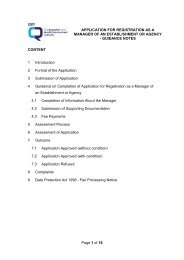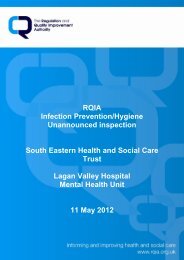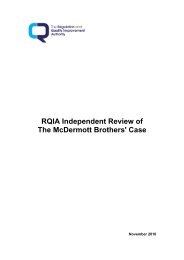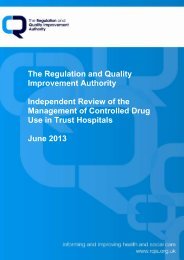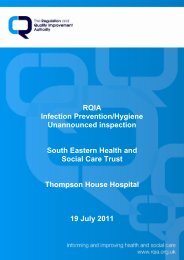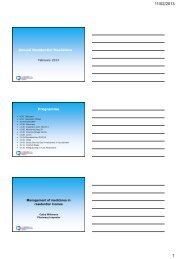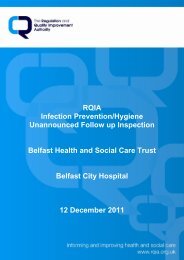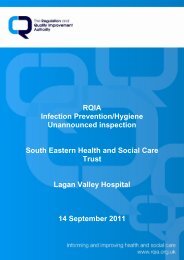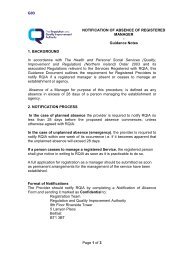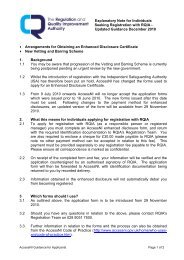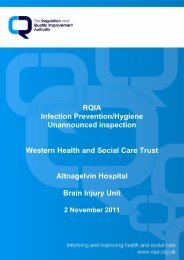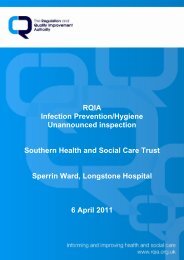Vulnerable Adults - Protocol for Joint Investigation of Alleged and ...
Vulnerable Adults - Protocol for Joint Investigation of Alleged and ...
Vulnerable Adults - Protocol for Joint Investigation of Alleged and ...
Create successful ePaper yourself
Turn your PDF publications into a flip-book with our unique Google optimized e-Paper software.
Page No<br />
Foreword 1<br />
1 Introduction 3<br />
2 Definition <strong>of</strong> a <strong>Vulnerable</strong> Adult 5<br />
3 Aims <strong>and</strong> Objectives 6<br />
4 Principles 7<br />
5 Rights <strong>and</strong> Responsibilities 8<br />
6 Reporting 11<br />
7 Initial Assessment 14<br />
Consultation - Planning <strong>and</strong> <strong>Investigation</strong><br />
8 <strong>Joint</strong> <strong>Investigation</strong> Interviews 20<br />
Glossary <strong>of</strong> Terms 30
Appendix 1:<br />
Appendix 2:<br />
Appendix 3:<br />
Appendix 4:<br />
Appendix 5:<br />
Appendix 6:<br />
Appendix 7:<br />
Appendix 8:<br />
The European Convention <strong>for</strong> the Protection <strong>of</strong><br />
Human Rights <strong>and</strong> Fundamental Freedoms into<br />
the UK Domestic Law - The Human Rights Act<br />
1998 Main Conventions Rights<br />
Human Rights List <strong>of</strong> Considerations<br />
Contact Details <strong>for</strong> Referrals to Public Protection<br />
Units, PSNI<br />
Contact details <strong>for</strong> Designated Officers <strong>and</strong><br />
Contact points <strong>for</strong> Out-<strong>of</strong>-Hours Emergency Social<br />
Work Co-ordinators<br />
Contact Details <strong>for</strong> the Regulation <strong>and</strong> Quality<br />
Improvement Authority<br />
Form AJP1: Record <strong>of</strong> <strong>Joint</strong> Agency Consultation<br />
Form AJP 2: Strategy <strong>for</strong> <strong>Investigation</strong><br />
Form AJP 3: Clarification Discussion
In recent years, significant ef<strong>for</strong>ts have been made within Health<br />
<strong>and</strong> Social Services <strong>and</strong> the Police Service to establish procedural<br />
<strong>and</strong> operational arrangements in order to respond effectively to the<br />
abuse or exploitation <strong>of</strong> vulnerable adults. This has involved a<br />
considerable degree <strong>of</strong> interagency liaison in order to develop<br />
effective partnership working which will help to prevent abuse <strong>and</strong><br />
respond appropriately <strong>and</strong> sensitively when it is alleged, suspected<br />
or occurs.<br />
Measures designed to support vulnerable <strong>and</strong> intimidated<br />
witnesses introduced in 2003 have contributed to even closer<br />
working arrangements between police <strong>of</strong>ficers <strong>and</strong> health <strong>and</strong><br />
social services staff.<br />
This <strong>Protocol</strong> is an important aspect <strong>of</strong> these changes. It outlines<br />
the roles <strong>and</strong> responsibilities <strong>of</strong> the respective agencies <strong>and</strong><br />
provides guidance about joint working arrangements <strong>and</strong><br />
investigation. It has been developed in partnership between the<br />
Police Service <strong>of</strong> Northern Irel<strong>and</strong> (PSNI), Department <strong>of</strong> Health,<br />
Social Services <strong>and</strong> Public Safety (DHSSPS), the Regulation <strong>and</strong><br />
Quality Improvement Authority (RQIA), the Health <strong>and</strong> Social Care<br />
Trusts <strong>and</strong> the <strong>for</strong>mer Health <strong>and</strong> Social Services Boards in<br />
Northern Irel<strong>and</strong>. It is based on the recognition <strong>of</strong> the need <strong>for</strong><br />
more co-ordinated interagency working to ensure that vulnerable<br />
adults, who are at risk <strong>of</strong> abuse, receive protection, support <strong>and</strong><br />
equitable access to the criminal justice system.<br />
The <strong>Protocol</strong> has been developed on the basis <strong>of</strong> research, best<br />
practice <strong>and</strong> on extant guidance, both regional <strong>and</strong> from elsewhere<br />
in the UK which requires agencies to develop interagency policies,<br />
procedures <strong>and</strong> joint protocols that draw on good practice <strong>and</strong> to<br />
investigate <strong>and</strong> take action when a vulnerable adult is believed to<br />
be at risk <strong>of</strong> abuse. 1.2.3<br />
1 Bailey A (2001) ‘Factors influencing police investigation <strong>of</strong> sexual crimes committed<br />
against people who have a learning disability <strong>and</strong> implications <strong>for</strong> public policy’.<br />
2 ‘No Secrets: Guidance on developing <strong>and</strong> implementing multi-agency policies <strong>and</strong><br />
procedures to protect vulnerable adults from abuse’. Home Office/DOH 2000.<br />
3 ‘Safeguarding <strong>Vulnerable</strong> <strong>Adults</strong> Regional Adult Protection Policy & Procedural<br />
Guidance’, September 2006.<br />
1
Although other agencies will be involved in aspects <strong>of</strong> the<br />
investigative process, the PSNI, Trusts <strong>and</strong> the RQIA have<br />
traditionally taken the lead roles in investigating abuse <strong>and</strong><br />
reporting crimes. The <strong>Protocol</strong> has been designed as a basis <strong>for</strong><br />
improved interagency working <strong>and</strong> will need to be closely<br />
monitored, reviewed <strong>and</strong> revised in the light <strong>of</strong> experience. It is<br />
supported by an ongoing programme <strong>of</strong> interagency training.<br />
We commend this <strong>Protocol</strong> to all who are involved in this critical<br />
<strong>and</strong> dem<strong>and</strong>ing area <strong>of</strong> work <strong>and</strong> would like to place on record our<br />
thanks to all who contributed to its development.<br />
Chief Executive<br />
Health <strong>and</strong> Social<br />
Care Board<br />
Assistant Chief<br />
Constable Criminal<br />
Justice<br />
Police Service <strong>of</strong><br />
Northern Irel<strong>and</strong><br />
Chief Executive<br />
Regulation <strong>and</strong> Quality<br />
Improvement Authority<br />
2 2
1.1 The PSNI <strong>and</strong> Health <strong>and</strong> Social Care (HSC) bodies are committed<br />
to tackling abuse in all its <strong>for</strong>ms <strong>and</strong> to the development <strong>of</strong><br />
collaborative working which will enhance arrangements <strong>for</strong> the<br />
protection <strong>and</strong> support <strong>of</strong> vulnerable individuals <strong>and</strong> groups. This<br />
will include responding to the specific needs <strong>of</strong> vulnerable <strong>and</strong><br />
intimidated victims <strong>of</strong> crime. In 1998, the Home Office published a<br />
report prepared by an Interdepartmental Working Group on the<br />
treatment <strong>of</strong> vulnerable victims <strong>and</strong> witnesses, entitled ‘Speaking<br />
Up <strong>for</strong> Justice’. 4 The report recommended that the existing special<br />
measures introduced <strong>for</strong> children, e.g. live CCTV links <strong>and</strong> video<br />
recorded evidence-in-chief, be extended to include vulnerable<br />
adults.<br />
1.2 The subsequent enactment <strong>of</strong> the Criminal Evidence (Northern<br />
Irel<strong>and</strong>) Order in 1999 (the ‘Criminal Evidence Order’) made<br />
provision <strong>for</strong> these arrangements, or ‘special measures’ to be<br />
introduced locally. Guidance on the application <strong>of</strong> special<br />
measures can be found in ‘Achieving Best Evidence in Criminal<br />
Proceedings: Guidance <strong>for</strong> <strong>Vulnerable</strong> Intimidated Witnesses,<br />
including Children’ (‘Achieving Best Evidence’). 5<br />
1.3 Other statutory agencies, <strong>for</strong> example, the RQIA, <strong>and</strong> voluntary<br />
organisations may be involved in aspects <strong>of</strong> the investigative<br />
process. However, the PSNI <strong>and</strong> HSC Trusts are primarily<br />
responsible <strong>for</strong> the investigation <strong>of</strong> abuse <strong>and</strong> the protection <strong>of</strong><br />
vulnerable adults. This <strong>Protocol</strong> is designed to ensure staff from<br />
these agencies work together in a way that ensures the well-being<br />
<strong>and</strong> rights <strong>of</strong> vulnerable adults are paramount. It also helps to<br />
ensure that people receive equitable access to justice.<br />
1.4 This <strong>Protocol</strong> sets out a framework <strong>for</strong> joint working in a complex<br />
area <strong>of</strong> practice <strong>and</strong> emphasises the need to involve all other<br />
relevant agencies in in<strong>for</strong>mation sharing, early assessment <strong>and</strong> the<br />
planning process. It is important that Trust <strong>and</strong> PSNI staff read this<br />
<strong>Protocol</strong> in conjunction with ‘Safeguarding <strong>Vulnerable</strong> <strong>Adults</strong><br />
4 ‘Speaking up <strong>for</strong> Justice’ - Home Office (1998).<br />
5 ‘Achieving Best Evidence in Criminal Proceedings: Guidance <strong>for</strong> <strong>Vulnerable</strong> or<br />
Intimidated Witnesses, including Children’ - Home Office Communication Directorate<br />
(2002). Work is currently being done to produce a version specifically <strong>for</strong> Northern<br />
Irel<strong>and</strong>.<br />
3 3
Regional Adult Protection Policy <strong>and</strong> Procedural Guidance’,<br />
September 2006 (‘Safeguarding <strong>Vulnerable</strong> <strong>Adults</strong>’). Police <strong>of</strong>ficers<br />
should also be mindful <strong>of</strong> relevant PSNI Service Procedures. This<br />
<strong>Protocol</strong> extends to suspected crimes in domiciliary, community<br />
<strong>and</strong> hospital care if the victim is a vulnerable adult as defined in<br />
paragraph 2.1.<br />
1.5 The Aims <strong>and</strong> Objectives (Section 3), Principles (Section 4) <strong>and</strong><br />
Rights <strong>and</strong> Responsibilities (Section 5) set out in this <strong>Protocol</strong><br />
extend to vulnerable adults both as victims <strong>and</strong> as witnesses.<br />
4 4
Definition <strong>of</strong> a <strong>Vulnerable</strong> Adult<br />
2.1 For the purposes <strong>of</strong> this <strong>Protocol</strong> the definition <strong>of</strong> a vulnerable adult has<br />
been taken from ‘Safeguarding <strong>Vulnerable</strong> <strong>Adults</strong>’. It applies to adults:<br />
a) who are 18 years old <strong>and</strong> over; <strong>and</strong><br />
b) who are, or may be, in need <strong>of</strong> community care services OR<br />
are resident in a continuing care facility by reason <strong>of</strong><br />
mental or other disability, age or illness OR who are, or may<br />
be, unable to take care <strong>of</strong> themselves, OR unable to protect<br />
themselves against significant harm or exploitation.<br />
2.2 This is more inclusive than the definition <strong>of</strong> vulnerability contained in<br />
the Criminal Evidence Order. It is likely that some cases <strong>of</strong> alleged or<br />
suspected abuse against vulnerable adults will require a joint approach<br />
to investigation but will not qualify <strong>for</strong> the special measures outlined in<br />
the Order in relation to accessing the criminal justice system. It should<br />
also be borne in mind that the human <strong>and</strong> civil rights <strong>of</strong> the individual<br />
may have been breached.<br />
2.3 ‘No Secrets’ which was produced by the Department <strong>of</strong> Health, London<br />
<strong>and</strong> the Home Office <strong>of</strong>fered a brief definition <strong>of</strong> abuse as being:<br />
‘the violation <strong>of</strong> an individual’s human <strong>and</strong> civil rights by any<br />
other person’.<br />
The original DHSS guidance, produced in 1996 as a basis <strong>for</strong><br />
developing Board <strong>and</strong> Trust adult protection policies, <strong>of</strong>fered a more<br />
detailed definition <strong>of</strong> abuse as being:<br />
‘the physical, psychological, emotional, financial, sexual<br />
maltreatment or neglect <strong>of</strong> a vulnerable adult by another person.<br />
The abuse may be a single act or repeated over a period <strong>of</strong> time. It<br />
may take one <strong>for</strong>m or a multiple <strong>of</strong> <strong>for</strong>ms. The lack <strong>of</strong> appropriate<br />
action can also be a <strong>for</strong>m <strong>of</strong> abuse. Abuse can occur in a<br />
relationship where there is the expectation <strong>of</strong> trust <strong>and</strong> can be<br />
perpetrated by a person/persons, in breach <strong>of</strong> that trust, who have<br />
influence over the life <strong>of</strong> a dependant, whether they be in<strong>for</strong>mal or<br />
<strong>for</strong>mal carers, staff or family members or others. It can occur<br />
outside such a relationship’.<br />
5<br />
5
3.1 The overall aim <strong>of</strong> the <strong>Protocol</strong> is to prevent abuse by promoting a<br />
multi-agency approach to the protection <strong>of</strong> vulnerable adults, <strong>and</strong> to<br />
ensure that they receive equitable access to justice in a way that<br />
promotes their rights <strong>and</strong> well-being.<br />
3.2 The <strong>Protocol</strong> aims to:<br />
• ensure effective communication <strong>and</strong> collaboration between<br />
Trusts, RQIA <strong>and</strong> PSNI to protect vulnerable adults;<br />
• involve Trusts <strong>and</strong> PSNI in determining whether a single agency or<br />
a joint agency investigation is required;<br />
• provide a framework <strong>for</strong> early consultation, cross referral <strong>of</strong><br />
appropriate cases <strong>and</strong> joint working arrangements <strong>for</strong> investigation<br />
<strong>and</strong> interviewing;<br />
• define the roles <strong>and</strong> responsibilities <strong>of</strong> PSNI <strong>and</strong> Trust staff in the<br />
joint investigation;<br />
• minimise the number <strong>of</strong> interviews conducted with the victim; <strong>and</strong><br />
• ensure that protective measures are paramount <strong>and</strong> run in parallel<br />
with the criminal inquiry or any other lines <strong>of</strong> enquiry, such as civil<br />
action or disciplinary proceedings.<br />
6 6
4.1 The <strong>Protocol</strong> aims to promote the following principles in protecting<br />
vulnerable adults from abuse <strong>and</strong> the investigation <strong>of</strong> alleged or<br />
suspected crimes:<br />
the well-being <strong>and</strong> rights <strong>of</strong> the vulnerable adult are paramount;<br />
the processes should minimise distress to the vulnerable adult by<br />
maximising co-operation between agencies;<br />
adult protection procedures must be properly followed; <strong>and</strong><br />
mechanisms should be available to resolve differences <strong>of</strong> opinion<br />
amongst staff/agencies through appropriate management<br />
structures.<br />
7 7
5.1 The <strong>Protocol</strong> is also committed to ensuring that the rights <strong>of</strong> vulnerable<br />
adults are upheld. These include the right to:<br />
• receive protection <strong>for</strong> themselves <strong>and</strong> their property under the law;<br />
• be supported in reporting the circumstances <strong>of</strong> any abuse;<br />
• have alleged, suspected or confirmed cases <strong>of</strong> abuse thoroughly<br />
investigated as a matter <strong>of</strong> urgency;<br />
• have options <strong>for</strong> resolution <strong>and</strong> the appropriate processes explained<br />
to them;<br />
• be supported in making decisions about how they wish to proceed<br />
in the event <strong>of</strong> abuse <strong>and</strong> to be kept in<strong>for</strong>med <strong>of</strong> progress;<br />
• have issues <strong>of</strong> consent <strong>and</strong> capacity considered;<br />
• be given in<strong>for</strong>mation in accessible <strong>for</strong>mats on how to protect<br />
themselves;<br />
• be given practical help in protecting themselves;<br />
• be supported when deciding whether to pursue a <strong>for</strong>mal complaint;<br />
• be subjected to the minimum degree <strong>of</strong> disruption; <strong>and</strong><br />
• receive support on a longer-term basis, following the abuse.<br />
5.2 In order to promote these rights effectively PSNI, Trust <strong>and</strong> RQIA staff<br />
must be aware <strong>of</strong> their responsibilities in this very difficult area <strong>of</strong> work.<br />
If an allegation <strong>of</strong> abuse does not appear to relate to criminal conduct,<br />
there is no statutory duty to report the matter to the PSNI <strong>and</strong> the<br />
decision about whether or not to investigate should be judged on the<br />
‘best interest’ test. In the case <strong>of</strong> non-criminal matters it may not be in<br />
the best interests <strong>of</strong> the vulnerable adult to investigate if the person has<br />
specifically indicated a preference <strong>for</strong> no investigation. However, in<br />
reaching this conclusion, it is necessary to take into account the<br />
capacity <strong>of</strong> the person making the decision <strong>and</strong> any other regulatory or<br />
personnel arrangements, e.g. disciplinary procedures, referral to a<br />
8<br />
8
pr<strong>of</strong>essional body such as the Northern Irel<strong>and</strong> Social Care Council<br />
(NISCC); etc.<br />
5.3 Although all members <strong>of</strong> society are duty bound to report <strong>of</strong>fences, this<br />
<strong>Protocol</strong> requires staff to consider the cross-referral <strong>of</strong> alleged or<br />
suspected <strong>of</strong>fences. In general, the PSNI is authorised to investigate<br />
alleged or suspected criminal abuse against the vulnerable adult where<br />
this is agreed to be in the best interests <strong>of</strong> the person. In the majority<br />
<strong>of</strong> cases, in particular where the vulnerable adult is deemed to have<br />
capacity, the PSNI will only proceed with the consent <strong>of</strong> the vulnerable<br />
adult. In practice this means that the vulnerable adult should be willing<br />
to make a complaint to the PSNI. However, there are some exceptions<br />
to this e.g. where the vulnerable adult is deemed not to have capacity,<br />
is subject to undue influence or where others may be at risk. In some<br />
circumstances the PSNI may also intervene to prevent a crime being<br />
committed.<br />
5.4 Where criminal abuse may have been committed a referral between the<br />
agencies should be made <strong>and</strong> an agreed strategy should be developed<br />
which takes account <strong>of</strong> the wishes <strong>of</strong> the alleged victim. The PSNI <strong>and</strong><br />
Trust should work sensitively in these enquiries <strong>and</strong> must secure the<br />
co-operation <strong>and</strong> consent <strong>of</strong> the victim unless there may be issues in<br />
relation to capacity <strong>and</strong>/or the potential <strong>for</strong> abuse to third parties. After<br />
referral between agencies the agreed strategy should take account <strong>of</strong><br />
the wishes <strong>of</strong> the alleged victim. When there are concerns, but no real<br />
grounds to suspect that an <strong>of</strong>fence may have been committed, there is<br />
a duty on Trust staff to investigate <strong>and</strong> report any criminal <strong>of</strong>fences or<br />
concerns that may be identified as a result <strong>of</strong> the investigation.<br />
5.5 When judging whether the individual has capacity to give or withhold<br />
consent, guidance in ‘Safeguarding <strong>Vulnerable</strong> <strong>Adults</strong>’ should be<br />
followed. This should take into account pr<strong>of</strong>essional opinion as<br />
appropriate e.g. psychiatrists, psychologists, GPs, nurses <strong>and</strong> social<br />
workers.<br />
5.6 The Human Rights Act 1998 has been fully effective from<br />
2 nd October 2000. It incorporates the European Convention <strong>for</strong> the<br />
Protection <strong>of</strong> Human Rights <strong>and</strong> Fundamental Freedoms into United<br />
Kingdom Domestic Law. This makes it unlawful <strong>for</strong> public authorities to<br />
act in a manner which is incompatible with the rights <strong>and</strong> freedoms<br />
guaranteed by the Convention. Appendix 1 sets out the main<br />
Convention Rights enshrined in the 1998 Act.<br />
9<br />
9
Public authorities can interfere with an individual’s rights providing it is<br />
lawful, proportionate <strong>and</strong> necessary in a democratic society.<br />
Lawful means ‘prescribed by law’ <strong>and</strong> the legal basis <strong>for</strong> any restriction<br />
on rights <strong>and</strong> freedoms must be established <strong>and</strong> identified.<br />
Proportionate means any interference with a Convention Right must<br />
be proportionate to the intended objective <strong>and</strong> not arbitrary or unfair.<br />
Necessary in a Democratic Society means (1) Does it fulfil a pressing<br />
social need? (2) Does it pursue a legitimate aim? <strong>and</strong> (3) Is it<br />
proportionate to the aims being pursued?<br />
The Decision Making Process<br />
In applying the key principles <strong>of</strong> lawfulness, proportionality <strong>and</strong> whether<br />
it is necessary in a democratic society, a public authority representative<br />
must ask the following questions:<br />
• Is there a legal basis <strong>for</strong> my actions?<br />
• Is it proportionate <strong>and</strong> necessary in a democratic society?<br />
• Is the procedure involved in the decision-making process fair <strong>and</strong><br />
does it contain safeguards against abuse?<br />
• Was there an alternative <strong>and</strong> less restrictive course <strong>of</strong> action<br />
available? (The intervention should be strictly limited to what is<br />
required to achieve the objective).<br />
• Is the restriction required <strong>for</strong> legitimate purposes?<br />
• If I fail to interfere with this individual’s rights could there be a more<br />
serious outcome in not af<strong>for</strong>ding the individual adequate protection<br />
in fulfilment <strong>of</strong> their Article 2 rights?<br />
Decisions to interfere with an individual’s rights may be subject to<br />
scrutiny by the Courts. However, if public authorities can show that they<br />
applied the relevant Human Rights principles when making their<br />
decision, they are less likely to be over-ruled. It is very important to<br />
keep notes <strong>and</strong> decisions should be recorded in full (see Appendix 2).<br />
10 10
6.1 This <strong>Protocol</strong> is designed to be compatible with current ‘Safeguarding<br />
<strong>Vulnerable</strong> <strong>Adults</strong>’ guidance in requiring all staff to report suspected,<br />
alleged or confirmed instances <strong>of</strong> abuse. It provides a framework<br />
within which staff exercise their pr<strong>of</strong>essional judgement <strong>and</strong> discharge<br />
their legal responsibility. It ensures that all cases are given appropriate<br />
consideration <strong>and</strong> are not screened out inappropriately. Added<br />
safeguards to prevent this include the requirement to report cases to a<br />
designated adult protection <strong>of</strong>ficer (‘Designated Officer’) <strong>and</strong> to consult,<br />
where necessary, with the relevant Police Liaison Officer (see<br />
paragraph 6.6). Where a crime is suspected or alleged <strong>and</strong> the<br />
vulnerable adult does not wish to make a <strong>for</strong>mal complaint, the<br />
agencies should consider the following factors:<br />
the individual’s capacity to provide consent to a <strong>for</strong>mal complaint;<br />
the opportunity to prevent crime being committed;<br />
the extent to which other vulnerable persons, including children, are<br />
likely to be at risk; <strong>and</strong><br />
whether the vulnerable adult is subject to undue influence or<br />
coercion.<br />
6.2 A referral to the PSNI does not automatically mean that a joint<br />
investigation will be initiated. Such a decision should involve<br />
discussion with the Police Liaison Officer. Where the PSNI is in<strong>for</strong>med<br />
directly <strong>of</strong> suspected abuse which is clearly non-criminal, the individual<br />
should be made aware <strong>of</strong> other sources <strong>of</strong> support <strong>and</strong> options to have<br />
the matter resolved <strong>and</strong> his/her agreement sought to refer to the Trust.<br />
6.3 <strong>Alleged</strong> or suspected instances <strong>of</strong> abuse occurring in a regulated<br />
service must be reported to the RQIA. The RQIA must ensure that<br />
alleged or suspected instances <strong>of</strong> abuse in regulated services are<br />
referred to the PSNI <strong>and</strong> the appropriate Trust.<br />
6.4 Reports <strong>of</strong> alleged or suspected abuse, which may be a criminal<br />
<strong>of</strong>fence, will be categorised as:<br />
(a) Sexual (e.g. rape, indecent assault); or<br />
(b) Non-sexual (e.g. physical assault, theft).<br />
11 11
The PSNI will be responsible <strong>for</strong> determining the category <strong>of</strong> <strong>of</strong>fence.<br />
6.5 Where alleged or suspected crimes are reported to the PSNI they have<br />
a duty to conduct criminal investigations. The decision to investigate<br />
will be made at a Strategy Discussion <strong>and</strong> will be in<strong>for</strong>med by the views<br />
<strong>of</strong> the victim <strong>and</strong> Trust staff.<br />
6.6 Referral to PSNI by Health <strong>and</strong> Social Care Trusts<br />
a) In all cases <strong>of</strong> alleged or suspected criminal abuse the Designated<br />
Officer <strong>for</strong> the Trust should discuss the case with the relevant Police<br />
Liaison Officer. It will be the responsibility <strong>of</strong> the Police Liaison<br />
Officer to help determine whether the matter may involve criminal<br />
abuse <strong>and</strong> thereby to in<strong>for</strong>m the decision concerning what level <strong>of</strong><br />
enquiry/investigation is necessary.<br />
b) <strong>Alleged</strong> or suspected abuse, whether sexual or non-sexual, should<br />
be reported to the Inspector, Public Protection Unit (PPU) or<br />
nominated deputy who holds the role <strong>of</strong> Police Liaison Officer. The<br />
Inspector or nominated deputy will allocate any investigation<br />
regarding the alleged abuse whether it is uni<strong>for</strong>m or the Criminal<br />
<strong>Investigation</strong> Department (CID).<br />
c) Outside <strong>of</strong> PPU working hours (9.00 am – 5.00 pm Monday to<br />
Friday), the Duty Inspector in the relevant district should be<br />
contacted who will determine what preliminary action is required. In<br />
all such reported cases <strong>of</strong> alleged abuse the Duty Inspector will<br />
in<strong>for</strong>m the PPU Inspector or nominated deputy as soon as is<br />
practicable.<br />
d) A list <strong>of</strong> contact numbers <strong>for</strong> the PPUs is contained in Appendix 3.<br />
6.7 Referral to Health <strong>and</strong> Social Care Trusts by PSNI<br />
a) Police <strong>of</strong>ficers who encounter vulnerable adults who may have been<br />
the subject <strong>of</strong> abuse, whether criminal or not, should contact the<br />
relevant Designated Officer to establish whether the vulnerable<br />
adult is known, or should be referred, to the Trust.<br />
b) Where concerns are raised in relation to the care or treatment,<br />
which may involve criminal abuse <strong>of</strong> a vulnerable adult outside<br />
normal working hours (9.00 am - 5.00 pm Monday to Friday),<br />
12
these concerns should be referred immediately to the Out-<strong>of</strong>-<br />
Hours Social Work Co-ordinator (the Co-ordinator).<br />
c) The Co-ordinator will take whatever action is necessary to ensure<br />
the protection <strong>of</strong> the vulnerable adult. Depending on the scale <strong>of</strong><br />
the concern this may involve referral to other agencies. The<br />
Co-ordinator will make the appropriate Designated Officer <strong>for</strong> the<br />
Trust aware <strong>of</strong> the referral details <strong>and</strong> any action taken/required,<br />
as a matter <strong>of</strong> urgency on the first working day following the date<br />
<strong>of</strong> the referral being made.<br />
d) Contact details <strong>for</strong> Trusts <strong>and</strong> contact points <strong>for</strong> Out-<strong>of</strong>-Hours<br />
Services can be found in Appendix 4.<br />
<strong>Alleged</strong> or Suspected Criminal Abuse in a Regulated Service<br />
6.8 When criminal abuse is alleged or suspected to have occurred in a<br />
regulated service <strong>and</strong> is reported to, or comes to the attention <strong>of</strong> the<br />
RQIA, the relevant programme head at the RQIA should ensure that<br />
the matter is referred to both the Police Liaison Officer <strong>and</strong> to the<br />
relevant Trust Designated Officer as soon as is practicable (see<br />
Appendix 5 <strong>for</strong> contact details). If an incident <strong>of</strong> suspected or alleged<br />
criminal abuse in a regulated service comes to the attention <strong>of</strong> Trust<br />
staff, the RQIA must be in<strong>for</strong>med by the Designated Officer as soon as<br />
is practicable.<br />
Referral from PSNI to RQIA<br />
6.9 Police <strong>of</strong>ficers, who encounter a vulnerable adult who is a service user<br />
within a regulated service <strong>and</strong> who may have been subjected to abuse,<br />
whether criminal or not, should contact the relevant Trust Designated<br />
Officer <strong>and</strong> RQIA. This will enable RQIA to establish if there has been<br />
any breach in the relevant legislation that requires regulatory action.<br />
Inappropriate Referral<br />
6.10 In any event where a referral is made inappropriately between agencies<br />
the receiving agency will have responsibility <strong>for</strong> referring the matter to<br />
the appropriate agency.<br />
13<br />
13
Clarification <strong>of</strong> Roles<br />
7.1 The PSNI <strong>and</strong> Trust staff have specialist <strong>and</strong> complementary skills in<br />
terms <strong>of</strong> assessing <strong>and</strong> investigating allegations <strong>of</strong> abuse <strong>of</strong> vulnerable<br />
adults. The process is outlined in Figure 1 (see page 17). In<br />
appropriate cases it is necessary to combine these skills to provide<br />
maximum protection <strong>and</strong> support <strong>for</strong> those individuals who have been<br />
the subject <strong>of</strong>, or are at risk <strong>of</strong> harm. This <strong>Protocol</strong> recognises that the<br />
various agencies may have different priorities or emphasis in relation to<br />
adult protection work.<br />
7.2 The <strong>Protocol</strong> is not designed to make Trust or PSNI personnel<br />
undertake roles which are at variance with their primary pr<strong>of</strong>essional<br />
responsibilities. However it is intended to provide a basis <strong>for</strong><br />
maximising co-operation <strong>and</strong> a shared underst<strong>and</strong>ing <strong>of</strong> the issues<br />
involved. Differences <strong>of</strong> opinion, or approach, amongst staff should be<br />
resolved in a manner that does not hinder the protection <strong>of</strong> the<br />
vulnerable adult. Protection <strong>of</strong> the individual is paramount <strong>and</strong> staff<br />
should not inappropriately screen out cases by failure to follow this<br />
<strong>Protocol</strong>.<br />
7.3 The strategy to be adopted must be in<strong>for</strong>med by the pr<strong>of</strong>essional views<br />
<strong>of</strong> PSNI, Trust <strong>and</strong>, as appropriate, RQIA staff. The strategy <strong>for</strong><br />
investigation should always be influenced by in<strong>for</strong>mation gained from<br />
pr<strong>of</strong>essionals or other persons who may have knowledge <strong>of</strong> the<br />
vulnerable adult, his/her family or circumstances.<br />
7.4 The primary objective <strong>of</strong> PSNI, Trust <strong>and</strong> RQIA is the protection <strong>of</strong> the<br />
vulnerable adult. In addressing this shared objective, the primary role<br />
<strong>of</strong> PSNI personnel is determined by their statutory responsibility to<br />
protect life <strong>and</strong> property, preserve order, prevent crime <strong>and</strong>, where a<br />
criminal <strong>of</strong>fence has been committed, bring <strong>of</strong>fenders to justice.<br />
7.5 The primary role <strong>of</strong> Trust <strong>and</strong> RQIA staff is determined by their<br />
statutory responsibility <strong>and</strong> Duty <strong>of</strong> Care, to promote the care <strong>and</strong> wellbeing<br />
<strong>of</strong> vulnerable adults in situations <strong>of</strong> alleged or confirmed abuse.<br />
14 14
7.6 Assaults (including minor assaults), thefts, criminal damage, sexual<br />
assaults <strong>and</strong> threats <strong>of</strong> <strong>for</strong>ce or violence are all likely to be criminal<br />
<strong>of</strong>fences. PSNI <strong>and</strong> Trust staff must recognise that the non cooperation<br />
<strong>of</strong> the victim does not always preclude a prosecution.<br />
However, the views <strong>of</strong> the victim are vital to the decision to prosecute.<br />
<strong>Joint</strong> Agency Consultation<br />
7.7 When either Trust or PSNI personnel identify the need <strong>for</strong> a joint<br />
agency approach, a staff member from the referring agency will take<br />
responsibility <strong>for</strong> instigating a <strong>Joint</strong> Agency Consultation. This should<br />
be the person within the Trust deemed to be responsible <strong>for</strong> the<br />
decision to proceed in cases <strong>of</strong> alleged or confirmed abuse. The<br />
Designated Officer will take responsibility <strong>for</strong> co-ordinating the practical<br />
arrangements associated with this action.<br />
7.8 The purpose <strong>of</strong> the Consultation is to discuss the case with other<br />
relevant agencies <strong>and</strong> organisations <strong>and</strong> to reach a decision on the<br />
need <strong>for</strong> a <strong>Joint</strong> <strong>Investigation</strong> involving Trust <strong>and</strong> PSNI. This<br />
communication may be by telephone or direct contact <strong>and</strong> should occur<br />
within 24 hours <strong>of</strong> the decision that Consultation with the other agency<br />
is necessary.<br />
7.9 The outcome <strong>of</strong> this Consultation may be:<br />
• no further action;<br />
• a Trust investigation;<br />
• a criminal investigation by PSNI; or<br />
• a <strong>Joint</strong> <strong>Investigation</strong> involving Trust <strong>and</strong> PSNI.<br />
The results <strong>of</strong> this Consultation must be clearly recorded <strong>and</strong> shared<br />
between agencies. Form AJP1 - Record <strong>of</strong> <strong>Joint</strong> Agency Consultation<br />
(Appendix 6) should be used <strong>for</strong> this process. The completion <strong>and</strong><br />
appropriate sharing <strong>of</strong> this <strong>and</strong> other records, e.g. Form AJP2 -<br />
Strategy <strong>for</strong> <strong>Investigation</strong> (Appendix 7) <strong>and</strong> Form AJP3 - Clarification<br />
Discussion (Appendix 8) is the responsibility <strong>of</strong> the lead agency in the<br />
investigation. Where it is agreed that a Trust investigation is<br />
appropriate the guidance contained in ‘Safeguarding <strong>Vulnerable</strong> <strong>Adults</strong>’<br />
should be followed.<br />
15 15
Criteria <strong>for</strong> <strong>Joint</strong> <strong>Investigation</strong> by Trust <strong>and</strong> PSNI<br />
7.10 A detailed consideration <strong>of</strong> the need <strong>for</strong> a <strong>Joint</strong> <strong>Investigation</strong> will be<br />
triggered when there is an allegation or suspicion that one <strong>of</strong> the<br />
criminal <strong>of</strong>fences described below has been committed against a<br />
vulnerable adult. The likelihood or otherwise <strong>of</strong> a prosecution is not a<br />
criterion <strong>for</strong> a <strong>Joint</strong> <strong>Investigation</strong>.<br />
• A sexual <strong>of</strong>fence committed against a vulnerable adult;<br />
• Physical abuse or ill treatment amounting to a criminal <strong>of</strong>fence;<br />
• Financial abuse involving a criminal <strong>of</strong>fence, e.g. fraud, theft; or<br />
abuse which involves a criminal <strong>of</strong>fence e.g. blackmail.<br />
Preliminary In<strong>for</strong>mation Gathering<br />
7.11 Following the decision <strong>of</strong> the <strong>Joint</strong> Agency Consultation to initiate a<br />
<strong>Joint</strong> <strong>Investigation</strong>, each agency will nominate a staff member to gather<br />
in<strong>for</strong>mation <strong>for</strong> the Strategy Planning Meeting which will be the basis<br />
<strong>for</strong> planning any subsequent investigation. The nominated <strong>of</strong>ficer will<br />
carry out checks on internal systems <strong>for</strong> in<strong>for</strong>mation that may be <strong>of</strong> use<br />
in deciding the strategy to be employed. At this stage consideration<br />
must be given to the communication needs <strong>of</strong> all those involved.<br />
Strategy Planning Meeting<br />
7.12 When sufficient preliminary in<strong>for</strong>mation is available to facilitate the<br />
development <strong>of</strong> a strategy <strong>for</strong> dealing with the case, a Strategy<br />
Planning Meeting should be convened. This should occur as soon as<br />
is practicable. The responsibility <strong>for</strong> convening this meeting lies with<br />
the designated staff member who initiated the <strong>Joint</strong> Agency<br />
Consultation.<br />
16 16
I<br />
N<br />
I<br />
T<br />
I<br />
A<br />
L<br />
A<br />
S<br />
S<br />
E<br />
S<br />
S<br />
M<br />
E<br />
N<br />
T<br />
S<br />
Figure 1<br />
Trust/PSNI<br />
PSNI<br />
TRUST<br />
Criminal<br />
Offence<br />
Identified<br />
Suspected<br />
J<br />
O<br />
I<br />
N<br />
T<br />
A<br />
G<br />
E<br />
N<br />
C<br />
Y<br />
C<br />
O<br />
N<br />
S<br />
U<br />
L<br />
T<br />
A<br />
T<br />
I<br />
O<br />
N<br />
<strong>Joint</strong> Agency<br />
S<br />
T<br />
R<br />
A<br />
T<br />
E<br />
G<br />
Y<br />
P<br />
L<br />
A<br />
N<br />
N<br />
I<br />
N<br />
G<br />
M<br />
E<br />
E<br />
T<br />
I<br />
N<br />
G<br />
No Further Action<br />
Key to Diagram<br />
= The process to be followed <strong>for</strong> <strong>Joint</strong> Agency <strong>Investigation</strong><br />
17<br />
RQIA, as required<br />
Interim<br />
Protection<br />
Plan<br />
Measures<br />
Agreed<br />
I<br />
N<br />
V<br />
E<br />
S<br />
T<br />
I<br />
G<br />
A<br />
T<br />
I<br />
O<br />
N<br />
P<br />
L<br />
A<br />
N<br />
Protection<br />
Lead<br />
Social Services<br />
Who?<br />
What?<br />
Where?<br />
When?<br />
<strong>Investigation</strong><br />
Lead<br />
PSNI<br />
Protection Plan<br />
Review<br />
I<br />
N<br />
V<br />
E<br />
S<br />
T<br />
I<br />
G<br />
A<br />
T<br />
I<br />
O<br />
N<br />
C<br />
A<br />
S<br />
E<br />
C<br />
O<br />
N<br />
F<br />
E<br />
R<br />
E<br />
N<br />
C<br />
E<br />
S<br />
17
7.13 The purpose <strong>of</strong> the Strategy Planning Meeting is to ensure an early<br />
exchange <strong>of</strong> in<strong>for</strong>mation <strong>and</strong> to clarify what action needs to be taken<br />
jointly or separately in the investigation. It is an action orientated<br />
discussion, which should be convened to plan the investigation <strong>and</strong> agree<br />
any necessary interim protection measures.<br />
7.14 A Strategy Planning Meeting will always include PSNI, Trust <strong>and</strong> RQIA<br />
staff, where appropriate. Other pr<strong>of</strong>essionals, agency representatives <strong>and</strong><br />
persons with specialist knowledge/skills may also be included to ensure<br />
the protection <strong>of</strong> the vulnerable adult.<br />
7.15 Where the Strategy Planning Meeting concludes that a vulnerable adult<br />
has been the victim <strong>of</strong> criminal abuse or may be at risk <strong>of</strong> serious criminal<br />
abuse <strong>and</strong> that issues arise about the protection <strong>of</strong> the individual, the<br />
Strategy Planning Meeting should address the following points:<br />
• whether action is needed to protect the vulnerable adult <strong>and</strong> who will<br />
be responsible <strong>for</strong> such action;<br />
• the need to consider the issue <strong>of</strong> capacity to consent <strong>and</strong> the most<br />
appropriate person to deal with it;<br />
• the requirement <strong>for</strong> a medical examination to be undertaken <strong>and</strong> if so,<br />
by whom;<br />
• what issues <strong>of</strong> special needs, race, culture, gender, language,<br />
communication or religion are raised in the case, how <strong>and</strong> by whom<br />
they are to be addressed <strong>and</strong> what advice needs to be sought;<br />
• what specialist support or advice may be needed <strong>and</strong> who obtains it;<br />
• what other in<strong>for</strong>mation is needed to complete the investigation <strong>and</strong><br />
who will seek it;<br />
• the order in which the interviews will take place <strong>and</strong> who will carry out<br />
each interview;<br />
• practical arrangements <strong>for</strong> reporting back to those involved in the<br />
investigation; <strong>and</strong><br />
18
• refining internal processes <strong>for</strong> communication <strong>and</strong> agreeing the<br />
communication strategy, <strong>and</strong> who should lead it, where there are<br />
matters likely to be <strong>of</strong> public interest.<br />
7.16 It is the responsibility <strong>of</strong> the person who convenes the meeting to ensure<br />
that a record <strong>of</strong> the Strategy Planning Meeting is made <strong>and</strong> shared<br />
between agencies. Form AJP2 - Strategy <strong>for</strong> <strong>Investigation</strong> (Appendix 7)<br />
should be used <strong>for</strong> this purpose. Although strategy planning will generally<br />
take place in a <strong>for</strong>mally constituted meeting, there may be occasions<br />
where this may need to be conducted by telephone.<br />
19
8.1 Interviews with vulnerable adults will be conducted in accordance with the<br />
guidelines contained in ‘Achieving Best Evidence’.<br />
<strong>Joint</strong> Interviews by Police Officers <strong>and</strong> Social Workers<br />
8.2 Where it is agreed in the Strategy Planning Meeting that interviews should<br />
be conducted jointly by a police <strong>of</strong>ficer <strong>and</strong> social worker the following<br />
procedures will apply. It must be emphasised that the decision about<br />
which interviews should be conducted jointly, <strong>and</strong> the sequence <strong>of</strong><br />
interviews, is a matter <strong>for</strong> the group planning the investigation at the<br />
Strategy Planning Meeting.<br />
Selection <strong>of</strong> Interviewers<br />
8.3 Only PSNI <strong>and</strong> Trust personnel, who have received specialist training in<br />
joint interviewing, should be appointed to the task. Where a vulnerable<br />
adult has requested the interviewer to be <strong>of</strong> a specific gender all<br />
reasonable steps must be taken to facilitate this request.<br />
Supervision <strong>of</strong> Interviewers<br />
8.4 It will be the responsibility <strong>of</strong> each agency to ensure that the interview <strong>and</strong><br />
investigation process is properly supervised <strong>and</strong> supported by relevant<br />
managers who have been trained in these procedures.<br />
Clarification Discussion<br />
8.5 In making decisions about the method <strong>of</strong> interviewing vulnerable adults it<br />
may be necessary to have a short Clarification Discussion. This should<br />
normally be undertaken by the persons who will conduct any subsequent<br />
interview. However, where this is not possible, the Clarification<br />
Discussion may be carried out by other staff who have received <strong>Joint</strong><br />
<strong>Protocol</strong> training. Once a decision has been made that an interview <strong>of</strong> a<br />
vulnerable adult should be conducted on video, a specialist investigative<br />
interviewer will be tasked to carry out the interview.<br />
20
8.6 The purpose <strong>of</strong> the Clarification Discussion is:<br />
• to establish whether or not the vulnerable adult has made an allegation<br />
or raised suspicions which have led to the referral. The substance <strong>and</strong><br />
detail <strong>of</strong> the allegation or disclosure should not be part <strong>of</strong> the<br />
Clarification Discussion;<br />
• to assess the vulnerable adult’s willingness <strong>and</strong> ability to pursue the<br />
matter to court;<br />
• to in<strong>for</strong>m the PSNI decision about which <strong>for</strong>mat should be used <strong>for</strong> the<br />
interview, (e.g. videotape, statement or question <strong>and</strong> answer.<br />
Videotaping is the preferred method <strong>of</strong> interviewing vulnerable adults.<br />
Statements are the alternative <strong>and</strong> questions <strong>and</strong> answers should only<br />
be used when neither videotaping or statements are possible) <strong>and</strong><br />
whether the use <strong>of</strong> video in the interview is likely to maximise the<br />
quality <strong>of</strong> that particular vulnerable adult’s evidence.<br />
8.7 The Clarification Discussion must be recorded <strong>and</strong> responsibility <strong>for</strong> this<br />
will lie with the person conducting it. The Clarification Discussion is not an<br />
investigative interview <strong>and</strong> should never replace or over-shadow the <strong>Joint</strong><br />
<strong>Investigation</strong> interview with the vulnerable adult. Strictly no further<br />
examination <strong>of</strong> the allegation should take place beyond that which has<br />
been disclosed. It is important not to coach the interviewee in respect <strong>of</strong><br />
the interview. If the discussion includes the disclosure <strong>of</strong> a criminal<br />
<strong>of</strong>fence, that part must be recorded verbatim <strong>and</strong> contemporaneously, or<br />
at the very least as soon as possible after the contact. Even if no criminal<br />
disclosure is made, accurate recording is essential. Decisions about risk<br />
may be made on the strength <strong>of</strong> the Clarification Discussion. Form AJP3<br />
(Appendix 8) must be completed in respect <strong>of</strong> every Clarification<br />
Discussion.<br />
Preparation <strong>for</strong> a <strong>Joint</strong> Interview<br />
8.8 The following should be considered when preparing <strong>for</strong> a <strong>Joint</strong> Interview:<br />
the needs <strong>and</strong> circumstances <strong>of</strong> the vulnerable adult (e.g.<br />
development, impairments, degree <strong>of</strong> trauma experienced, whether<br />
he/she is now in a safe environment);<br />
the vulnerable adult’s state <strong>of</strong> mind (e.g. likely distress, <strong>and</strong>/or shock);<br />
21
perceived fears about intimidation <strong>and</strong> recrimination;<br />
the circumstances <strong>of</strong> the suspected <strong>of</strong>fence (e.g. relationship <strong>of</strong> the<br />
vulnerable adult to the alleged <strong>of</strong>fender);<br />
location <strong>of</strong> interview;<br />
time <strong>of</strong> interview;<br />
preferred gender <strong>of</strong> interviewer; <strong>and</strong><br />
additional requirements (e.g. preparation <strong>of</strong> staff <strong>and</strong> interpreters).<br />
(Note: Where a language barrier exists an independent interpreter<br />
should be used as opposed to a family member).<br />
Other persons with specialist skills may be needed to assist the<br />
interviewer conduct the interview. This might include, specialist<br />
communicators using sign language, etc.<br />
8.9 Purposes <strong>of</strong> the <strong>Joint</strong> Interview<br />
The purposes <strong>of</strong> the <strong>Joint</strong> Interview are to:<br />
• promote the well-being <strong>and</strong> protection <strong>of</strong> the vulnerable adult;<br />
• validate or negate allegations or suspicions <strong>of</strong> abuse by helping the<br />
vulnerable adult to give as much in<strong>for</strong>mation as possible;<br />
• avoid multiple interviews where possible;<br />
• identify the suspected abuser;<br />
• ensure that all decisions made are based on the experience <strong>of</strong> the<br />
vulnerable adult <strong>and</strong> not the influence or beliefs <strong>of</strong> the interviewer;<br />
<strong>and</strong><br />
• provide a record <strong>of</strong> the vulnerable adult’s evidence-in-chief which<br />
may be used at a consequent criminal hearing.<br />
22
Persons Present at <strong>Joint</strong> Interview<br />
8.10 Normally no-one else should be in the interview room apart from the<br />
vulnerable adult <strong>and</strong> the interviewers. Limiting the number <strong>of</strong> people<br />
present at the interview should lessen the possibility <strong>of</strong> the vulnerable<br />
adult feeling overwhelmed by the situation <strong>and</strong> uncom<strong>for</strong>table about<br />
revealing in<strong>for</strong>mation.<br />
8.11 It is good practice <strong>for</strong> the vulnerable adult to know that a supportive<br />
person is available in an adjoining room. A suspected <strong>of</strong>fender should<br />
never be present in an interview. However, if it is the vulnerable adult’s<br />
wish to have a supportive person present in the interview room it should<br />
be made clear to that person that he/she must take no part in the<br />
interview.<br />
Recording In<strong>for</strong>mation that is not Video Recorded<br />
8.12 When a <strong>Joint</strong> Interview with a vulnerable adult is not video recorded a<br />
written account <strong>of</strong> the in<strong>for</strong>mation given should be made. If it is<br />
assessed by the interviewers, or on the basis <strong>of</strong> consultation with other<br />
expert opinion, that the vulnerable adult is capable <strong>of</strong> giving an account<br />
<strong>of</strong> relevant matters, the police <strong>of</strong>ficer may invite the adult to make a<br />
signed, written statement on Form 38/36. The evidence <strong>of</strong> a vulnerable<br />
adult who is not capable <strong>of</strong> making a statement should be recorded as<br />
questions <strong>and</strong> answers <strong>and</strong> certified by them <strong>and</strong> any other person<br />
present.<br />
The Video Interview<br />
8.13 The Criminal Evidence Order provides <strong>for</strong> the video recording <strong>of</strong><br />
interviews with vulnerable adults to be admitted as evidence-in-chief at<br />
criminal proceedings. The guidance accompanying the legislation is<br />
designed to help those police <strong>of</strong>ficers <strong>and</strong> any Trust staff involved in<br />
making a video recording <strong>of</strong> an interview with a vulnerable adult, where it<br />
is intended that the result should be admissible in criminal proceedings.<br />
8.14 The Order is ‘Permissive’ legislation. There should be a general<br />
assumption that a video interview will be conducted where the criteria<br />
are met (e.g. an eligible witness in an indictable [Crown Court] case).<br />
Use <strong>of</strong> a video <strong>for</strong> interviews is not necessary in all cases <strong>and</strong>, on<br />
occasions, might add to the interviewee’s trauma unnecessarily. The<br />
decision as to whether the interview will be videotaped will be taken by<br />
23
the investigating police <strong>of</strong>ficer in consultation with Trust staff following<br />
the Clarification Discussion.<br />
Planning the <strong>Joint</strong> Interview<br />
8.15 In order to be fully <strong>and</strong> properly prepared <strong>for</strong> an interview the <strong>Joint</strong><br />
<strong>Investigation</strong> Team <strong>of</strong> PSNI <strong>and</strong> Trust staff should normally plan the<br />
interview in line with the ‘four phased’ approach set out in ‘Achieving<br />
Best Evidence’ <strong>and</strong> adhere to the criteria which it has identified. The four<br />
phases are:<br />
Rapport;<br />
Free Narrative;<br />
Questioning; <strong>and</strong><br />
Closure.<br />
8.16 Planning should include deciding whether PSNI or Trust team member<br />
should take the role <strong>of</strong> lead interviewer, the proposed time scale, any<br />
special arrangements/allowances which are required to take account <strong>of</strong><br />
the vulnerable adult’s individual difficulties, agreed signals on when to<br />
take breaks or terminate the interview. As video recording <strong>of</strong><br />
investigative interviews is aimed at providing evidence-in-chief at criminal<br />
courts, planning must include coverage <strong>of</strong> the ‘points-to-prove’ in criminal<br />
<strong>of</strong>fences.<br />
8.17 Where it appears, be<strong>for</strong>e interviewing a vulnerable adult, that the history<br />
<strong>of</strong> the case indicates a considerable amount <strong>of</strong> in<strong>for</strong>mation is likely to be<br />
<strong>for</strong>thcoming, a series <strong>of</strong> interviews may be planned. The second, third,<br />
etc, interviews in this series will be considered part <strong>of</strong> the original<br />
interview without any automatic need to consult with the Public<br />
Prosecution Service (the PPS).<br />
8.18 The <strong>Joint</strong> <strong>Investigation</strong> Team must be given sufficient time to carry out<br />
this planning process, prior to a <strong>Joint</strong> Investigative Interview. Failure to<br />
do so may limit the effectiveness <strong>of</strong> the process <strong>and</strong> do a disservice to<br />
the vulnerable adult. Preparation will include the following activities:<br />
• Technical Preparation;<br />
• Consideration <strong>of</strong> Consultation with Specialists; <strong>and</strong><br />
• Consideration <strong>of</strong> Communicative Competency <strong>of</strong> <strong>Vulnerable</strong><br />
Adult <strong>and</strong> Interviewer.<br />
24
Technical Preparation<br />
8.19 The <strong>Joint</strong> <strong>Investigation</strong> Team will need to carefully prepare <strong>for</strong> the<br />
interview, ensure that the equipment is in working order, test <strong>for</strong> vision<br />
<strong>and</strong> sound quality <strong>and</strong> ensure that tapes are correctly prepared, checked<br />
<strong>and</strong> inserted. Consideration should also be given to whether other<br />
equipment will be needed, e.g. hearing aids, communication boards, etc.<br />
Consideration <strong>of</strong> Consultation with Specialists<br />
8.20 The <strong>Joint</strong> <strong>Investigation</strong> Team should consider the conclusions <strong>of</strong> the<br />
Clarification Discussion about the need to involve staff with specialist skills<br />
in the <strong>Joint</strong> Investigative Interview <strong>and</strong> any role they should take in it. Due<br />
to the nature <strong>of</strong> this type <strong>of</strong> investigative interviewing it will <strong>of</strong>ten be<br />
necessary to seek specialist assistance with issues such as<br />
communication difficulties, mental ill-health or learning disability. If a<br />
specialist is asked to facilitate the <strong>Joint</strong> Interview, he/she should be<br />
in<strong>for</strong>med <strong>of</strong> the purpose <strong>of</strong> the interview <strong>and</strong> the limitations placed on<br />
his/her role.<br />
8.21 If an interpreter is required to assist in criminal proceedings involving a<br />
vulnerable adult who uses sign language the person must have attained<br />
at least Stage 3 British Sign Language or Irish Sign Language<br />
qualification, as appropriate.<br />
Consideration <strong>of</strong> Communicative Competency <strong>of</strong> <strong>Vulnerable</strong> Adult<br />
<strong>and</strong> Interviewer<br />
8.22 The vulnerable adult <strong>and</strong> interviewers need to be able to achieve the<br />
minimum requirements <strong>for</strong> communication. The <strong>Joint</strong> <strong>Investigation</strong> Team<br />
must establish whether a vulnerable adult has a reliable method <strong>of</strong><br />
communication which he/she can use intentionally <strong>and</strong> that the<br />
interviewers can underst<strong>and</strong> either directly or via a suitable interpreter.<br />
8.23 If the vulnerable adult has specific difficulties with comprehension or use<br />
<strong>of</strong> language (vocabulary, ideas <strong>and</strong> grammar) associated with physical or<br />
intellectual impairment careful consideration must be given to how these<br />
could be overcome. Speech <strong>and</strong> language therapists, sign language<br />
interpreters or facilitators in augmentative communication may be<br />
required.<br />
8.24 The competency <strong>of</strong> the interviewers in communicating will be the single<br />
greatest factor in determining whether a vulnerable adult will be able to<br />
deal with, <strong>and</strong> participate effectively in, an interview situation. The<br />
25
interviewer will also require in<strong>for</strong>mation about the vulnerable adult’s<br />
knowledge <strong>and</strong> underst<strong>and</strong>ing <strong>of</strong> him/herself, about objects, about places<br />
<strong>and</strong> events <strong>and</strong> how these things may be affected by his/her impairment<br />
or disability.<br />
Conduct <strong>of</strong> the Interview<br />
8.25 The interviewers need to provide the vulnerable adult with in<strong>for</strong>mation at a<br />
level which will help him/her to underst<strong>and</strong> who <strong>and</strong> what will be involved.<br />
Initially they should cover:<br />
<br />
<br />
<br />
<br />
introduction <strong>of</strong> the social worker (or other pr<strong>of</strong>essional), the police<br />
<strong>of</strong>ficer <strong>and</strong> any other person who requires to be present, with an<br />
explanation <strong>of</strong> each <strong>of</strong> their roles;<br />
an explanation <strong>of</strong> the purpose <strong>of</strong> the interview in a sensitive way that<br />
the vulnerable adult can underst<strong>and</strong>;<br />
an acknowledgement that it is a difficult situation <strong>for</strong> the vulnerable<br />
adult <strong>and</strong> that some things, particularly sexual assault, may be<br />
difficult to talk about; <strong>and</strong><br />
introduction <strong>of</strong> the video equipment <strong>and</strong> seeking consent to use it in<br />
the interview.<br />
8.26 The following are categories <strong>of</strong> facts, which, if contained in the vulnerable<br />
adult’s evidence, will enable properly in<strong>for</strong>med decisions to be taken<br />
regarding the subsequent conduct <strong>of</strong> the investigation <strong>and</strong> ultimately<br />
whether or not to prosecute any person <strong>for</strong> any <strong>of</strong>fence committed against<br />
the vulnerable adult:<br />
• name/identity <strong>of</strong> the alleged abuser/<strong>of</strong>fender, his/her present<br />
whereabouts, <strong>and</strong> the relationship <strong>of</strong> that individual to the vulnerable<br />
adult;<br />
• the duration <strong>and</strong> extent <strong>of</strong> the abuse/<strong>of</strong>fence;<br />
• what happened in detail, when it happened, where, <strong>and</strong> how <strong>of</strong>ten,<br />
being mindful <strong>of</strong> the ‘points-to-prove’ <strong>for</strong> each <strong>of</strong>fence;<br />
• date/time <strong>of</strong> last occurrence, likelihood <strong>of</strong> physical evidence;<br />
26
• names/identity <strong>of</strong> anyone else having knowledge <strong>of</strong> the<br />
abuse/<strong>of</strong>fence;<br />
• names <strong>of</strong> anyone else involved in, or observing, the abuse/<strong>of</strong>fence;<br />
<strong>and</strong><br />
• identity <strong>of</strong> anyone the vulnerable adult has told about the<br />
abuse/<strong>of</strong>fence.<br />
8.27 After the interview, the vulnerable adult <strong>and</strong>/or their representative should<br />
be given as much in<strong>for</strong>mation as possible about what will happen next<br />
including arrangements <strong>for</strong> his/her protection. If he/she is to be<br />
interviewed again, he/she should be in<strong>for</strong>med <strong>of</strong> where <strong>and</strong> when it may<br />
take place.<br />
8.28 If the interview or series <strong>of</strong> interviews has/have been completed <strong>and</strong><br />
further in<strong>for</strong>mation comes to light which makes it necessary to conduct<br />
another interview with the vulnerable adult, or where it is believed the<br />
vulnerable adult has more to tell, this should be considered a further or<br />
supplementary interview. In this case the matter should be discussed with<br />
the PPS. This will cover cases where, <strong>for</strong> example, conflicting evidence<br />
comes to light, a vulnerable adult makes further disclosures or names<br />
other suspects. ‘Achieving Best Evidence’ should be referred to when<br />
considering the further interview <strong>of</strong> a vulnerable adult.<br />
8.29 Once the interview is complete, the <strong>Joint</strong> <strong>Investigation</strong> Team should give<br />
consideration to the individual’s need <strong>for</strong> any counselling or therapeutic<br />
requirements which this may have indicated. PSNI <strong>and</strong> the PPS must be<br />
in<strong>for</strong>med about the nature <strong>of</strong> such therapy in each case. This is to ensure<br />
that the evidence provided to a court is not contaminated or contradicted<br />
by the vulnerable adult.<br />
The <strong>Vulnerable</strong> Adult who Becomes a Suspect<br />
8.30 If a vulnerable adult becomes suspected <strong>of</strong> a crime during the course <strong>of</strong><br />
an interview, a decision will have to be made on whether to proceed or<br />
terminate the interview. The interviewers should take a short break to<br />
consult, <strong>and</strong> if necessary seek advice, on the matter, in addition to being<br />
mindful <strong>of</strong> the need <strong>for</strong> sensitive h<strong>and</strong>ling <strong>of</strong> the situation. If it is<br />
concluded that the evidence <strong>of</strong> the vulnerable adult as a suspect is<br />
paramount in a particular case, the interview should be terminated so that<br />
any further questioning can be carried out in accordance with the Police<br />
<strong>and</strong> Criminal Evidence (NI) Order 1989, (PACE) at an appropriate<br />
location.<br />
27 27
Further Interviews<br />
8.31 Occasions may arise where a police <strong>of</strong>ficer or a social worker may wish to<br />
further interview a vulnerable adult who is the victim <strong>of</strong> some criminal<br />
<strong>of</strong>fence. It will be the responsibility <strong>of</strong> that police <strong>of</strong>ficer or social worker to<br />
advise the other agency <strong>of</strong> the intention to further interview the individual.<br />
The same procedures will apply to a further interview as apply to the<br />
original interview. No agency should unilaterally conduct further<br />
interviews with the vulnerable adult who may be central to criminal<br />
proceedings.<br />
Records <strong>of</strong> <strong>Joint</strong> Investigative Interviews<br />
8.32 PSNI staff will retain a written statement, recorded as a <strong>Joint</strong> Interview, <strong>for</strong><br />
evidential purposes. A copy may be provided to Trust staff, provided that<br />
the vulnerable adult agrees. Where a <strong>Joint</strong> Interview has been video<br />
recorded the original will be labelled <strong>and</strong> secured <strong>for</strong> court purposes by<br />
the PSNI. The working copy will be available <strong>for</strong> viewing by Trust staff by<br />
arrangement with the <strong>of</strong>ficer-in-charge <strong>of</strong> the case. A log will be<br />
completed on each occasion that the tape is viewed by anyone <strong>and</strong> will<br />
detail the reasons <strong>for</strong> it having been viewed. This will be retained with the<br />
working copy <strong>of</strong> the tape.<br />
8.33 Arrangements <strong>for</strong> viewing the tape by persons other than those identified<br />
above, e.g. defence or any subsequent court hearing will be the<br />
responsibility <strong>of</strong> the PSNI. PSNI General Order C(c) 70/96 must be<br />
complied with. Where investigation involves PSNI <strong>and</strong> HSC participation,<br />
the police <strong>of</strong>ficer in the case will be responsible as the prime keeper <strong>of</strong> all<br />
exhibits, letters, drawings, notes, etc.<br />
Review <strong>of</strong> Ongoing Management <strong>of</strong> the Case<br />
8.34 When the <strong>for</strong>mal <strong>Joint</strong> Interview process has been concluded there may<br />
be a need <strong>for</strong> further interagency discussions, outside <strong>of</strong> any judicial<br />
procedures, to agree a course <strong>of</strong> action to address the practical <strong>and</strong><br />
emotional implications <strong>for</strong> the vulnerable adult, his/her carers <strong>and</strong> staff<br />
involved in the case. In the majority <strong>of</strong> cases this can be most<br />
comprehensively dealt with by convening a Case Conference, although<br />
other, less <strong>for</strong>malised, mechanisms should be considered to optimise<br />
client/family involvement in the process. This is the responsibility <strong>of</strong> the<br />
Designated Officer from the relevant Trust in consultation with PSNI<br />
colleagues. Consultation should also take place on an interagency basis<br />
to identify the need <strong>for</strong> any staff debriefing/counselling which may be<br />
required as a result <strong>of</strong> the work which has been undertaken.<br />
28
Achieving Best Evidence<br />
A voluntary code <strong>of</strong> practice <strong>for</strong> interviewing vulnerable witnesses <strong>for</strong> criminal<br />
proceedings <strong>and</strong> where video is used to record the witness’ testimony.<br />
Case Conference<br />
Is a meeting <strong>of</strong> those involved in a case which can include the client/victim.<br />
The purpose is to establish potential risk to the individual <strong>and</strong> what action, if<br />
any, would be required.<br />
Criminal <strong>Investigation</strong> Department (CID)<br />
Police team <strong>of</strong> Detective Officers based in each District Comm<strong>and</strong> Unit with<br />
responsibility <strong>for</strong> the investigation <strong>of</strong> crime other than sexual crime.<br />
Cross Examination<br />
The secondary stage <strong>of</strong> evidence giving in Court where the testimony that a<br />
witness has already given is examined by counsel <strong>for</strong> the defence.<br />
Counsel <strong>for</strong> the Defence<br />
The legal representative responsible <strong>for</strong> conducting the case <strong>for</strong> the defence.<br />
Designated Officer<br />
Person within the Trust responsible <strong>for</strong> managing investigations <strong>of</strong> suspected,<br />
alleged or confirmed instances <strong>of</strong> abuse against vulnerable adults.<br />
District Comm<strong>and</strong> Units<br />
There are eight District Comm<strong>and</strong> Units in Northern Irel<strong>and</strong> headed by a Chief<br />
Superintendent.<br />
Evidence<br />
The term ‘evidence’ in its legal sense embraces all matters exclusive <strong>of</strong> mere<br />
argument, which can be placed be<strong>for</strong>e a Court to prove or disprove any matter<br />
or fact, the truth <strong>of</strong> which is the subject <strong>of</strong> judicial investigation.<br />
30
Evidence-In-Chief<br />
The initial stage <strong>of</strong> giving evidence in Court where the witness is taken through<br />
their evidence by counsel <strong>for</strong> the prosecution.<br />
Form 38/36<br />
Form used by PSNI <strong>for</strong> making a written record <strong>of</strong> witness evidence when<br />
video is not seen as an appropriate <strong>for</strong>m <strong>of</strong> recording - known as ‘a statement’.<br />
Hearsay Evidence<br />
Evidence <strong>of</strong> what a person has heard another person, not the accused, say. It<br />
is not admissible in criminal proceedings.<br />
Investigating Officer<br />
Trust pr<strong>of</strong>essional with responsibility <strong>for</strong> investigating the alleged abuse. Their<br />
role is to establish the facts, look at alternatives available <strong>and</strong> to provide<br />
counselling <strong>and</strong> support.<br />
Line Manager<br />
Management grade within the Trust to whom an individual directly reports.<br />
Live Television Link<br />
A system allowed under the Police <strong>and</strong> Criminal Evidence (NI) Order 1989<br />
whereby certain witnesses can give evidence from a television monitor in a<br />
room separate from the main body <strong>of</strong> the Court.<br />
NISCC (Northern Irel<strong>and</strong> Social Care Council)<br />
NISCC is the independent regulatory body <strong>for</strong> the Northern Irel<strong>and</strong> Social Care<br />
work<strong>for</strong>ce, established to increase public protection by improving <strong>and</strong><br />
regulating st<strong>and</strong>ards <strong>of</strong> training <strong>and</strong> practice <strong>for</strong> social care workers.<br />
Nominated Officer<br />
The agency staff member with the delegated role <strong>of</strong> gathering in<strong>for</strong>mation <strong>for</strong><br />
the Strategy Planning Meeting which will be the basis <strong>for</strong> planning any<br />
subsequent investigation. The nominated <strong>of</strong>ficer will check internal systems<br />
<strong>for</strong> in<strong>for</strong>mation that may be <strong>of</strong> use in deciding the strategy to be employed.<br />
31
Points to Prove<br />
The ingredients <strong>of</strong> a criminal <strong>of</strong>fence, each <strong>of</strong> which must be satisfactorily<br />
proven in a criminal trial.<br />
Police Service Procedure<br />
A written instruction, which is issued to the PSNI.<br />
Protection Plan<br />
A plan developed to clarify the protection measures put in place to protect the<br />
individual. Roles <strong>and</strong> responsibilities <strong>for</strong> doing so are clearly identified.<br />
Public Prosecution Service (PPS)<br />
A body <strong>of</strong> legal staff who work independently from the Police <strong>and</strong> who are<br />
responsible <strong>for</strong> directing on cases <strong>for</strong>warded <strong>for</strong> prosecution or otherwise.<br />
Public Protection Units (PPUs)<br />
Police team with specific responsibility <strong>for</strong> the following:<br />
• Child Abuse Enquiry Unit;<br />
• Domestic Violence;<br />
• Management <strong>of</strong> Violent/Sex Offenders;<br />
• Missing <strong>and</strong> <strong>Vulnerable</strong> Persons Enquiries/<strong>Investigation</strong>s.<br />
Regulation <strong>and</strong> Quality Improvement Authority (RQIA)<br />
The RQIA is the independent body responsible <strong>for</strong> monitoring <strong>and</strong> inspecting<br />
the availability <strong>and</strong> quality <strong>of</strong> Health <strong>and</strong> Social Care services in Northern<br />
Irel<strong>and</strong>, <strong>and</strong> encouraging improvements in the quality <strong>of</strong> those services. The<br />
role <strong>of</strong> RQIA is to ensure that the Health <strong>and</strong> Social Care services in Northern<br />
Irel<strong>and</strong> are accessible, well managed <strong>and</strong> meet the required st<strong>and</strong>ards.<br />
Regulated Service<br />
The RQIA is responsible <strong>for</strong> registering, inspecting <strong>and</strong> encouraging<br />
improvement in a range <strong>of</strong> health <strong>and</strong> social care services delivered by<br />
statutory <strong>and</strong> independent providers, in accordance with The Health <strong>and</strong><br />
Personal Social Services (Quality, Improvement <strong>and</strong> Regulation) (Northern<br />
Irel<strong>and</strong>) Order 2003 <strong>and</strong> its supporting regulations.<br />
32
The services which it regulates include residential care homes; nursing homes;<br />
children's homes; independent health care providers; nursing agencies; adult<br />
placement agencies; domiciliary care agencies; residential family centres; day<br />
care settings; <strong>and</strong> boarding schools.<br />
Third Party Material<br />
Matters <strong>of</strong> potential relevance to a Police investigation, which are not in<br />
possession <strong>of</strong> PSNI.<br />
33
THE EUROPEAN CONVENTION FOR THE PROTECTION OF<br />
HUMAN RIGHTS AND FUNDAMENTAL FREEDOMS INTO THE UK DOMESTIC LAW<br />
MAIN CONVENTION RIGHTS:<br />
THE HUMAN RIGHTS ACT 1998<br />
Article 2<br />
Article 3<br />
Article 4<br />
Article 5<br />
Article 6<br />
Article 7<br />
Article 8<br />
Article 9<br />
Article 10<br />
Article 11<br />
Article 12<br />
Article 14<br />
Article 16<br />
Article 17<br />
Article 18<br />
- Right to life<br />
- Prohibition <strong>of</strong> torture<br />
- Prohibition <strong>of</strong> slavery <strong>and</strong> <strong>for</strong>ced labour<br />
- Right to liberty <strong>and</strong> security <strong>of</strong> person<br />
- Right to a fair trial<br />
- No punishment without law<br />
- Right to respect <strong>for</strong> private <strong>and</strong> family life<br />
- Freedom <strong>of</strong> thought, conscience <strong>and</strong> religion<br />
- Freedom <strong>of</strong> expression<br />
- Freedom <strong>of</strong> assembly <strong>and</strong> association<br />
- Right to marry<br />
- Prohibition <strong>of</strong> discrimination<br />
- Restrictions on political activity <strong>of</strong> aliens<br />
- Prohibition <strong>of</strong> abuse <strong>of</strong> rights<br />
- Limitation on use <strong>of</strong> restriction on rights<br />
FIRST PROTOCOL:<br />
Article 1<br />
Article 2<br />
Article 3<br />
- Protection <strong>of</strong> property<br />
- Right to education<br />
- Right to free elections<br />
SIXTH PROTOCOL:<br />
Article 1<br />
- Abolition <strong>of</strong> the death penalty
NOTE: The following Articles are omitted from the Act:<br />
Article 1<br />
Article 13<br />
Articles 15 - 59<br />
- Obligation to respect Human Rights<br />
- Right to effective remedy<br />
- Operational provisions <strong>for</strong> the European Court
HUMAN RIGHTS - List <strong>of</strong> Considerations<br />
If you cannot answer a question, you cannot proceed to the next question. Only take action<br />
when you have completed the list.<br />
1. Is there any necessity to take action?<br />
What are you doing? Why are you doing it?<br />
YES / NO<br />
2. Is there any legal basis upon which to take action? Is there a<br />
statutory/m<strong>and</strong>atory/discretionary power you are using? If so, state it. If not, on what<br />
basis are you taking action? (You should seek legal advice).<br />
3. What are the Human Rights implications <strong>of</strong> the proposed action? (Go through<br />
Convention List <strong>and</strong> mark the relevant article <strong>and</strong> the relevant limitation).<br />
(See Appendix 1)<br />
Specify Article <strong>and</strong> Limitation<br />
4. Is the proposed action proportionate? Is the scale <strong>of</strong> the action appropriate to the<br />
size <strong>of</strong> the problem? (i.e. consider whether it is intrusive or invasive). Is there an<br />
alternative?<br />
Give reasons <strong>for</strong> your decision
5. Is there an independent public remedy available? If not, consider what will be the<br />
effect <strong>of</strong> failure to give a remedy i.e. Ombudsman/Judicial Review/other Court<br />
action).<br />
Specify all available remedies<br />
6. If action is taken, is there “equality <strong>of</strong> arms”?<br />
Does the person have the same opportunity to gather<br />
evidence as you <strong>and</strong> present it to the Court/Tribunal?<br />
7. Is the action the least possible one?<br />
Is it the least intrusive or invasive?<br />
YES /<br />
YES /<br />
NO<br />
NO<br />
Signed:<br />
POST-EVENT EVALUATION<br />
Position:<br />
Dated:<br />
POST-EVENT EVALUATION<br />
Signed:<br />
Print Name:<br />
Position/Rank:<br />
Dated:
Police Service <strong>of</strong> Northern Irel<strong>and</strong> - Contact Number (028) 9065 0222<br />
Contact details <strong>for</strong> referrals to PPUs between<br />
9.00 am - 5.00 pm Monday to Friday<br />
A District - North <strong>and</strong> West Belfast<br />
Inspector Ext 28950 Sergeant Ext 28826<br />
B District - South <strong>and</strong> East Belfast<br />
Inspector Ext 23594 Sergeant Ext 23579<br />
C District - North <strong>and</strong> South Down, Ards <strong>and</strong> Castlereagh<br />
Det/Inspector Ext 31160 Sergeant Ext 15782<br />
D District - Antrim, Lisburn, Newtownabbey <strong>and</strong> Carrickfergus<br />
Inspector Ext 30321 Sergeant Ext 27630<br />
E District - Lurgan, Craigavon, Armagh, Banbridge <strong>and</strong> Newry <strong>and</strong> Mourne<br />
Inspector Ext 34022 Sergeant Ext 34017<br />
F District - Fermanagh, Omagh, Cookstown, Dungannon <strong>and</strong> South Tyrone<br />
Inspector Ext 54194 Sergeant Ext 54118<br />
G District - Foyle, Limavady, Strabane <strong>and</strong> Magherafelt<br />
Det/Inspector Ext 58565 Sergeant Ext 57019<br />
H District - Coleraine <strong>and</strong> Ballymena<br />
Inspector Ext 63901 Sergeant - Coleraine Ext 83102<br />
Sergeant - Ballymena Ext 63253<br />
In all referrals regarding <strong>Vulnerable</strong> <strong>Adults</strong> the Sergeant attached to the relevant PPU<br />
will be the first point <strong>of</strong> contact.<br />
Outside <strong>of</strong> usual <strong>of</strong>fice hours (9.00 am - 5.00 pm, Monday to Friday) the Duty Inspector in<br />
the relevant District should be contacted.
Contact details <strong>for</strong> Designated Officers <strong>and</strong> Contact points <strong>for</strong><br />
Out-<strong>of</strong>-Hours Emergency Social Work Co-ordinators<br />
HSC Trust<br />
Designated Officer Contact<br />
Belfast Phone: (028) 9032 7156<br />
South<br />
Eastern<br />
Phone: (028) 9266 5181 Ext 4544<br />
Western Phone: (028) 7131 4090<br />
Northern<br />
Learning Disability<br />
Phone: (028) 2766 1393<br />
Mental Health<br />
Phone: (028) 9441 3114<br />
Older People<br />
Phone: (028) 2563 5558<br />
Physical Disability <strong>and</strong> Sensory Impairment<br />
Phone: (028) 2766 1217<br />
Southern<br />
Learning Disability<br />
Phone: (028) 3752 2381<br />
Mental Health<br />
Phone: (028) 3883 1983<br />
Older People<br />
Phone: (028) 3082 5120<br />
Physical Disability <strong>and</strong> Sensory Impairment<br />
Phone: (028) 3833 3332
Out-<strong>of</strong>-Hours Emergency Social Work Co-ordinators - Contact Points<br />
Belfast Health <strong>and</strong> Social Care Trust <strong>and</strong><br />
South Eastern Health <strong>and</strong> Social Care Trust<br />
(Knockbracken Healthcare Park)<br />
(028) 9056 5444<br />
Northern Health <strong>and</strong> Social Care Trust<br />
(Holywell Hospital)<br />
Southern Health <strong>and</strong> Social Care Trust<br />
(Daisy Hill Hospital)<br />
Western Health <strong>and</strong> Social Care Trust<br />
(Altnagelvin Hospital)<br />
(028) 9446 8833<br />
(028) 3083 5000<br />
(028) 7134 5171
Contact details <strong>for</strong> the Regulation <strong>and</strong> Quality Improvement Authority<br />
between 9.00 am - 5.00 pm Monday to Friday<br />
The RQIA's headquarters is located in Belfast at :<br />
The Regulation <strong>and</strong> Quality Improvement Authority<br />
9th Floor Riverside Tower<br />
5 Lanyon Place<br />
BELFAST<br />
BT1 3BT<br />
Phone: (028) 9051 7500<br />
Contact details <strong>for</strong> the RQIA’s Omagh <strong>of</strong>fice are:<br />
The Regulation <strong>and</strong> Quality Improvement Authority<br />
Hilltop<br />
Tyrone <strong>and</strong> Fermanagh Hospital<br />
OMAGH<br />
BT79 0NS<br />
Phone: (028) 8224 5828
ADULT PROTECTION: FORM AJP1 - RECORD OF JOINT AGENCY CONSULTATION<br />
Referral by telephone on _______ /_____ /______________________________<br />
To: _____________________________ Designation: ____________________<br />
Person referring: ___________________ Designation: ____________________<br />
Address: _________________________________________________________<br />
Contact Tel No:<br />
Name <strong>of</strong> <strong>Vulnerable</strong> Adult: _____________________________________ DOB: __/__/___<br />
Home Address: __________________________________________________________<br />
Present Location:_________________________________________________________<br />
Gender*: M<br />
F<br />
Nature <strong>of</strong> Vulnerability*: Frail Older Person Dementia Learning Disability<br />
Physical/Sensory Disability Mental Illness Other (please specify)<br />
Is the <strong>Vulnerable</strong> Adult subject to any legal/statutory status?*<br />
(e.g. Guardianship, Non-Molestation Order) Yes No<br />
If yes please provide details: _________________________________________________<br />
Details <strong>of</strong> any current or past involvement with Social Services, Police <strong>and</strong>/or the Regulation<br />
<strong>and</strong> Quality Improvement Authority:____________________________________________<br />
Name <strong>of</strong> Carer/Next <strong>of</strong> Kin: __________________________________________________<br />
Address: _______________________________________________________________<br />
Contact Tel No: _________________________<br />
WHAT IS THE MAIN FORM OF SUSPECTED, ADMITTED OR KNOWN ABUSE?*<br />
Physical Sexual Psychological/Emotional<br />
Financial Neglect Institutional Abuse<br />
Other (please specify)<br />
HAS THERE BEEN PREVIOUS CONCERN OR EVIDENCE OF ABUSE?*<br />
Yes No Don’t know<br />
If yes, what was the nature <strong>of</strong> the concern <strong>and</strong> the outcome?<br />
*Please tick appropriate box/es<br />
ORIGINAL FOR POLICE FILE AND COPY TO SOCIAL SERVICES
Outcome <strong>of</strong> <strong>Joint</strong> Agency Consultation*<br />
Single Agency <strong>Investigation</strong> by:<br />
Social Services Police RQIA<br />
<strong>Joint</strong> <strong>Investigation</strong> by:<br />
Social Services Police RQIA<br />
OR<br />
<strong>Protocol</strong> <strong>for</strong> <strong>Joint</strong> <strong>Investigation</strong> <strong>of</strong> alleged <strong>and</strong> suspected cases <strong>of</strong> abuse <strong>of</strong> vulnerable<br />
adults<br />
Please specify if any other follow up will take place.<br />
Signature <strong>of</strong> person completing <strong>for</strong>m: _____________________________<br />
Print Name: __________________________________________________<br />
Designation: _________________________________________________<br />
Date: ________________________<br />
• Please tick appropriate box/es<br />
ORIGINAL FOR POLICE FILE AND COPY TO SOCIAL SERVICES
ADULT PROTECTION: FORM AJP2 - STRATEGY FOR INVESTIGATION<br />
Name <strong>of</strong> <strong>Vulnerable</strong> Adult: __________________________ DOB: __/___/__<br />
(A)<br />
PEOPLE IN ATTENDANCE/INVOLVED (NAME & AGENCY):<br />
OTHERS CONSULTED:<br />
(B)<br />
INITIAL STRATEGY: Date: ___/___/___<br />
Next <strong>of</strong> Kin/Carer to be in<strong>for</strong>med: YES/NO By Whom: ____________<br />
(i) Amendments to strategy Date:<br />
Telephone/Meeting*<br />
Persons Involved/Designation:<br />
(ii) Amendments to strategy Date:<br />
(C)<br />
PERSONS TO BE INTERVIEWED<br />
Telephone/Meeting*<br />
Persons Involved/Designation:<br />
* Please delete as appropriate<br />
ORIGINAL FOR POLICE FILE AND COPY TO SOCIAL SERVICES
1 Person making the allegation to clarify all facts about referral<br />
Name: ______________________________________________________<br />
Address: ____________________________________________________<br />
2 Next <strong>of</strong> kin or other carers:<br />
Name: ____________________ Relationship to <strong>Vulnerable</strong> Adult: ____________<br />
Address:__________________________________________________________<br />
3 Significant others<br />
(attach separate sheet if necessary)<br />
Name: ____________________________<br />
Relationship: _______________________<br />
Address: __________________________<br />
__________________________________<br />
4 The <strong>Vulnerable</strong> Adult<br />
Name: ____________________________<br />
Address: __________________________<br />
__________________________________<br />
5 The <strong>Alleged</strong> Perpetrator<br />
Name: ____________________________<br />
D.O.B:_____________________________<br />
Address: ___________________________<br />
Date & Time: __________________<br />
Venue:_______________________<br />
Who will conduct?<br />
SW:_________________________<br />
PSNI: ________________________<br />
Other: ________________________<br />
Date & Time: __________________<br />
Venue:_______________________<br />
Who will conduct?<br />
SW:_________________________<br />
PSNI: ________________________<br />
Other: ________________________<br />
Date & Time: __________________<br />
Venue:_______________________<br />
Who will conduct?<br />
SW:_________________________<br />
PSNI: ________________________<br />
Other: ________________________<br />
Relationship to <strong>Vulnerable</strong> Adult: __________________________________________<br />
* Please delete as appropriate<br />
ORIGINAL FOR POLICE FILE AND COPY TO SOCIAL SERVICES
(D)<br />
Has a statement <strong>of</strong> complaint been made? YES/NO*<br />
By Whom: __________________________<br />
Does the vulnerable adult have the capacity to:<br />
(a) Consent to interview? YES/NO*<br />
b) Consent to medical examination? YES/NO*<br />
On what basis were these decisions made? _____________________________<br />
________________________________________________________________<br />
Signature: ___________________ Designation: __________________________<br />
(<strong>of</strong> Person completing <strong>for</strong>m)<br />
Print Name: __________________ Date: _____________________________<br />
* Please delete as appropriate<br />
ORIGINAL FOR POLICE FILE AND COPY TO SOCIAL SERVICES
ADULT PROTECTION: FORM AJP3 - CLARIFICATION DISCUSSION<br />
Name: ________________________________________ DOB: ____/ ___ / _____<br />
Address:<br />
Date: _________________________________________ Time: ________________<br />
Venue: _____________________________________________________________<br />
CONSIDERATIONS:<br />
1 Has the adult previously made a clear disclosure <strong>of</strong> abuse or are there<br />
substantive grounds <strong>for</strong> suspecting abuse has occurred?<br />
Comment:<br />
__________________________________________________________________________<br />
__________________________________________________________________________<br />
2 Is the adult willing to engage in an interview?<br />
Comment:<br />
__________________________________________________________________________<br />
__________________________________________________________________________<br />
3 Is the adult able to engage in an interview?<br />
Comment:<br />
__________________________________________________________________________<br />
__________________________________________________________________________<br />
4 Has the purpose <strong>of</strong> the interview been explained to the adult?<br />
Comment:<br />
__________________________________________________________________________<br />
__________________________________________________________________________<br />
5 Which <strong>for</strong>mat is the most suitable <strong>for</strong> the interview? If a video interview<br />
appears to be the most appropriate option assess the adult’s willingness to<br />
be interviewed on video.<br />
Comment:<br />
__________________________________________________________________________<br />
__________________________________________________________________________<br />
Decision: VIDEO STATEMENT QUESTION AND ANSWER<br />
(Circle <strong>for</strong>mat to be used)
NATURE OF DISCUSSION:<br />
CONTEMPORANEOUS, VERBATIM RECORD OF DISCLOSURE:<br />
_____________________________________________________________<br />
_____________________________________________________________<br />
_____________________________________________________________<br />
_____________________________________________________________<br />
_____________________________________________________________<br />
_____________________________________________________________<br />
_____________________________________________________________<br />
_____________________________________________________________<br />
_____________________________________________________________<br />
_____________________________________________________________<br />
_____________________________________________________________<br />
(Please close with diagonal line)<br />
SIGNATURE OF PERSON MAKING NOTES: _______________________<br />
PRINT NAME: _________________________________________________<br />
DESIGNATION: __________________________ DATE: _____________<br />
(NOTE: Responsibility <strong>for</strong> completion rests with either Police or<br />
Social Services)
The <strong>Protocol</strong> has been produced by the Health & Social Care Board in partnership with the<br />
Health & Social Care Trusts, Police Service <strong>of</strong> Northern Irel<strong>and</strong> <strong>and</strong> The Regulation <strong>and</strong> Quality<br />
Improvement Authority.





